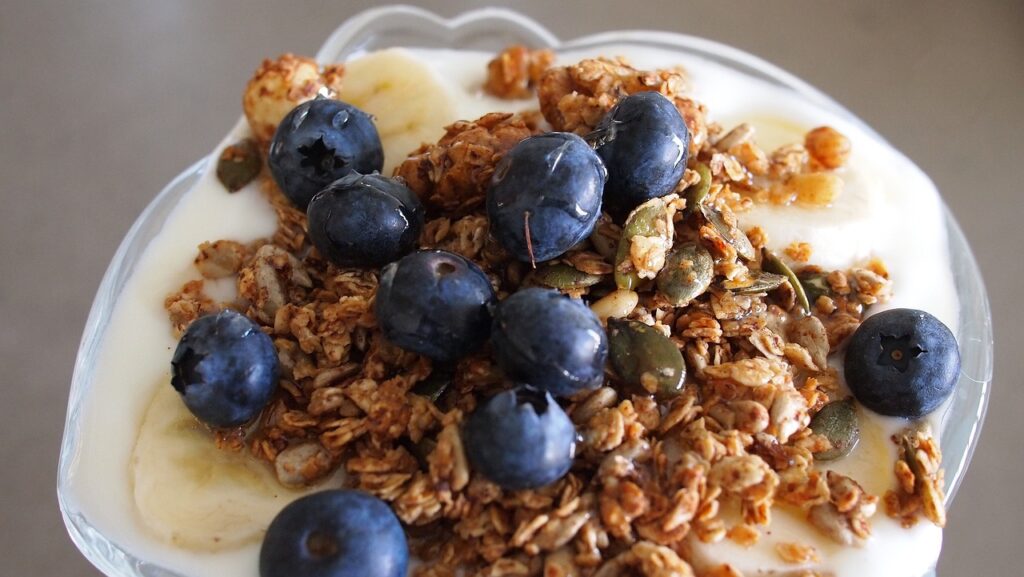
Benefits of Homemade Healthy Granola
- Control Over Ingredients: You can choose high-quality, wholesome ingredients and avoid additives, preservatives, and excessive sugars.
- Customization: You can tailor the flavor, sweetness, and texture to your liking, adding nuts, seeds, dried fruits, or chocolate chips based on your preferences.
- Cost-Effective: Making granola bars at home can be more economical than buying pre-packaged ones, especially when buying ingredients in bulk.
- Freshness: Homemade bars are often fresher and taste better since you can make them in smaller batches and consume them within a shorter time frame.
- Nutritional Value: You have the flexibility to create bars that are higher in protein, fiber, and essential nutrients by choosing nutrient-dense ingredients.
- Reduced Waste: Making your own granola bars can reduce packaging waste associated with store-bought options, contributing to a more sustainable lifestyle.
- Allergen-Free Options: If you or your family members have food allergies or sensitivities, homemade granola bars allow you to control and eliminate specific ingredients.
- Satisfaction and Reward: There’s a sense of accomplishment and satisfaction in creating something delicious and nutritious from scratch.
- Freshness: Homemade granola bars can be made in smaller batches, ensuring that you always have a fresh supply on hand.
The Nutrition Facts
The nutritional facts of homemade granola can vary significantly depending on the specific ingredients and proportions used. However, here’s a general overview of the typical nutritional profile for homemade granola, based on a standard recipe:
Nutritional Facts per 1/4 cup (approximately 30 grams) of homemade granola:
- Calories: 120-150
- Total Fat: 6-8 grams
- Saturated Fat: 1-2 grams
- Trans Fat: 0 grams
- Cholesterol: 0 milligrams
- Sodium: 5-10 milligrams
- Total Carbohydrates: 15-20 grams
- Dietary Fiber: 2-3 grams
- Sugars: 4-6 grams
- Protein: 2-4 grams
Key Ingredients and Their Nutritional Contributions:
- Oats: High in fiber, protein, and various vitamins and minerals.
- Nuts and Seeds (e.g., almonds, walnuts, chia seeds): Provide healthy fats, protein, and micronutrients like magnesium and vitamin E.
- Sweeteners (e.g., honey, maple syrup): Add sweetness and calories; choose natural options for better nutritional value.
- Dried Fruits (e.g., raisins, cranberries): Contribute natural sugars and fiber but also add to the calorie and sugar content.
- Oil (e.g., coconut oil, olive oil): Adds fat and calories; opt for healthier oil choices and use in moderation.

Replace Sugary Cereal with Wholesome Healthy Granola.
Replacing sugary cereal with homemade granola can offer several health benefits. Here are some reasons why homemade granola can be a healthier alternative:
- Lower Sugar Content: Many commercial cereals are high in added sugars, which can contribute to weight gain, diabetes, and other health issues. Homemade granola allows you to control the amount and type of sweeteners used, opting for natural sweeteners like honey or maple syrup in moderation.
- Whole Food Ingredients: Homemade granola often contains whole food ingredients like oats, nuts, seeds, and dried fruits that are rich in fiber, vitamins, minerals, and antioxidants. In contrast, many commercial cereals may contain refined grains, artificial flavors, and preservatives.
- Higher Nutritional Value: By choosing nutrient-dense ingredients and avoiding additives and preservatives, homemade granola can provide a better balance of macronutrients (carbohydrates, protein, and fats) and micronutrients (vitamins and minerals).
- Customization: Homemade granola allows for customization based on individual taste preferences and dietary needs. You can add a variety of nuts, seeds, and fruits to enhance flavor and nutritional value, while also accommodating allergies or food sensitivities.
- Reduced Processed Ingredients: Commercial cereals often contain processed and artificial ingredients, including colorings, flavorings, and preservatives. Homemade granola offers a cleaner ingredient list, free from unwanted additives and chemicals.
- Sustainability: Making granola at home can reduce packaging waste associated with individually packaged cereals, contributing to a more eco-friendly lifestyle.
- Cost-Effective: In the long run, making granola at home can be more cost-effective than purchasing premium or organic cereals, especially when buying ingredients in bulk.
- Control Over Portion Size: It’s easier to control portion sizes when making granola at home, helping to prevent overeating and promoting better portion control.
- Enjoyment and Satisfaction: Homemade granola can be tailored to suit personal tastes, resulting in a product that is more enjoyable and satisfying to eat than many commercial cereals.
By replacing sugary cereal with homemade granola, you can enjoy a delicious and nutritious breakfast or snack that supports overall health and well-being.

The Healthiest Granola Recipe
Ingredients
- 4 cups Old Fashioned Oats
- 1 cup Shreaded Cocunut
- 1 cup Sliced Almonds
- ½ cup Sunflower Seeds
- ½ cup Pumpkin Seeds
- ½ cup Cocunut or Olive Oil
- ⅔ cup Honey or Maple Syrup
Instructions
- On a baking tray lined with wax paper, combined all, mix well. Flatten out the moist granola on the baking dish. preheat oven at 260℉ bake for 2-3 hours stirring ocasionally until golden brown, remove from oven. While the granola is still hot remove the wax paper stir it aroung so it wont stick to tray once cooled place in a storage container and enjoy.
Video

Enjoy as cereal

Enjoy as a Snack

Enjoy as Parfait
Note: The links in this review are affiliate links, which means I will earn a small commission. This commission comes at no additional cost to you.









